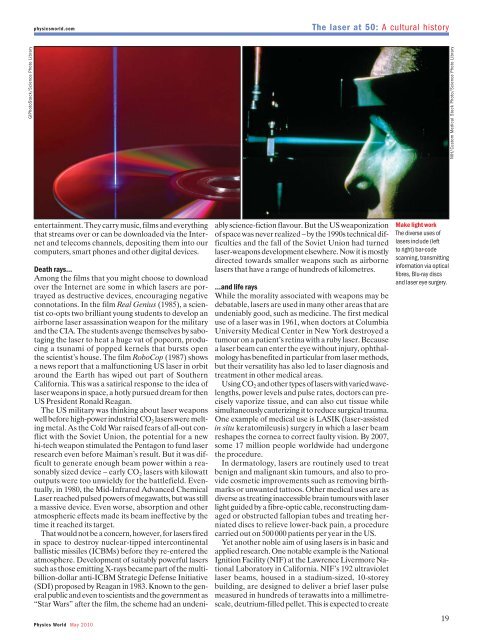special issue
special issue
special issue
You also want an ePaper? Increase the reach of your titles
YUMPU automatically turns print PDFs into web optimized ePapers that Google loves.
physicsworld.comThe laser at 50: A cultural historyGIPhotoStock/Science Photo LibraryNIH/Custom Medical Stock Photo/Science Photo Libraryentertainment. They carry music, films and everythingthat streams over or can be downloaded via the Inter -net and telecoms channels, depositing them into ourcomputers, smart phones and other digital devices.Physics World May 2010Death rays...Among the films that you might choose to downloadover the Internet are some in which lasers are portrayedas destructive devices, encouraging negativeconnotations. In the film Real Genius (1985), a scientistco-opts two brilliant young students to develop anairborne laser assassination weapon for the militaryand the CIA. The students avenge themselves by sabotagingthe laser to heat a huge vat of popcorn, produ -cing a tsunami of popped kernels that bursts openthe scientist’s house. The film RoboCop (1987) showsa news report that a malfunctioning US laser in orbitaround the Earth has wiped out part of SouthernCalifornia. This was a satirical response to the idea oflaser weapons in space, a hotly pursued dream for thenUS President Ronald Reagan.The US military was thinking about laser weaponswell before high-power industrial CO 2 lasers were meltingmetal. As the Cold War raised fears of all-out conflictwith the Soviet Union, the potential for a newhi-tech weapon stimulated the Pentagon to fund laserresearch even before Maiman’s result. But it was dif -ficult to generate enough beam power within a reasonablysized device – early CO 2 lasers with kilowattoutputs were too unwieldy for the battlefield. Even -tually, in 1980, the Mid-Infrared Advanced ChemicalLaser reached pulsed powers of megawatts, but was stilla massive device. Even worse, absorption and otheratmospheric effects made its beam ineffective by thetime it reached its target.That would not be a concern, however, for lasers firedin space to destroy nuclear-tipped intercontinentalballistic missiles (ICBMs) before they re-entered theatmosphere. Development of suitably powerful laserssuch as those emitting X-rays became part of the multibillion-dollaranti-ICBM Strategic Defense Initiative(SDI) proposed by Reagan in 1983. Known to the generalpublic and even to scientists and the government as“Star Wars” after the film, the scheme had an undeniablyscience-fiction flavour. But the US weaponizationof space was never realized – by the 1990s technical difficultiesand the fall of the Soviet Union had turnedlaser-weapons development elsewhere. Now it is mostlydirected towards smaller weapons such as airbornelasers that have a range of hundreds of kilometres....and life raysWhile the morality associated with weapons may bedebatable, lasers are used in many other areas that areundeniably good, such as medicine. The first medicaluse of a laser was in 1961, when doctors at ColumbiaUniversity Medical Center in New York destroyed atumour on a patient’s retina with a ruby laser. Becausea laser beam can enter the eye without injury, ophthalmologyhas benefited in particular from laser methods,but their versatility has also led to laser diagnosis andtreatment in other medical areas.Using CO 2 and other types of lasers with varied wavelengths,power levels and pulse rates, doctors can preciselyvaporize t<strong>issue</strong>, and can also cut t<strong>issue</strong> whilesimultaneously cauterizing it to reduce surgical trauma.One example of medical use is LASIK (laser-assistedin situ keratomileusis) surgery in which a laser beamreshapes the cornea to correct faulty vision. By 2007,some 17 million people worldwide had undergonethe procedure.In dermatology, lasers are routinely used to treatbenign and malignant skin tumours, and also to providecosmetic improvements such as removing birthmarksor unwanted tattoos. Other medical uses are asdiverse as treating inaccessible brain tumours with laserlight guided by a fibre-optic cable, reconstructing damagedor obstructed fallopian tubes and treating her -niated discs to relieve lower-back pain, a procedurecarried out on 500 000 patients per year in the US.Yet another noble aim of using lasers is in basic andapplied research. One notable example is the NationalIgnition Facility (NIF) at the Lawrence Livermore Na -tional Laboratory in California. NIF’s 192 ultravioletlaser beams, housed in a stadium-sized, 10-storeybuilding, are designed to deliver a brief laser pulsemeasured in hundreds of terawatts into a millimetrescale,deutrium-filled pellet. This is expected to createMake light workThe diverse uses oflasers include (leftto right) bar-codescanning, transmittinginformation via opticalfibres, Blu-ray discsand laser eye surgery.19



